Mechanical and Thermal Behavior of Fibrous Carbon Materials
Abstract
:1. Introduction
2. Materials and Methods
2.1. Commercial Fibrous Carbons Available
2.2. Mechanical Characterization
2.2.1. Classical (Destructive) Method: “Dynamic” Compression
2.2.2. Non-Destructive Method: Quasi-Static Mechanic Analysis
2.3. Thermal Conductivity Characterisation
3. Results and Discussion
3.1. Mechanical Properties of Commercial Fibrous Carbons
3.1.1. Destructive (“Dynamic”) Compression Method
- Effect of fiber orientation on compression properties
- Effect of felt bulk density on compression properties
3.1.2. Non-Destructive Method: Quasi-Static Mechanic Analysis
3.1.3. Comparison of Destructive and Non-Destructive Methods
3.2. Thermal Conductivity of Commercial Fibrous Carbons
3.2.1. Experimental Measurements of Effective Thermal Conductivity
3.2.2. Effective Thermal Conductivity of CFs Subjected to Compression
4. Conclusions
Supplementary Materials
Author Contributions
Funding
Institutional Review Board Statement
Informed Consent Statement
Data Availability Statement
Acknowledgments
Conflicts of Interest
References
- Kelly, P.; Umer, R.; Bickerton, S. Viscoelastic response of dry and wet fibrous materials during infusion processes. Compos. Part A Appl. Sci. Manuf. 2006, 37, 868–873. [Google Scholar] [CrossRef]
- Davies, T.J.; Tummino, J.J. High-Performance Vanadium Redox Flow Batteries with Graphite Felt Electrodes. C J. Carbon Res. 2018, 4, 8. [Google Scholar] [CrossRef] [Green Version]
- Kossenko, A.; Lugovskoy, S.; Averbukh, M. Electric and Hydraulic Properties of Carbon Felt Immersed in Different Dielectric Liquids. Materials 2018, 11, 650. [Google Scholar] [CrossRef] [Green Version]
- Bard, S.; Schönl, F.; Demleitner, M.; Altstädt, V. Influence of Fiber Volume Content on Thermal Conductivity in Transverse and Fiber Direction of Carbon Fiber-Reinforced Epoxy Laminates. Materials 2019, 12, 1084. [Google Scholar] [CrossRef] [PubMed] [Green Version]
- Dunlop, J.I. On the Compression Characteristics of Fibre Masses. J. Text. Inst. 1983, 74, 92–97. [Google Scholar] [CrossRef]
- Parikh, D.V.; Calamari, T.A.; Goynes, W.R.; Chen, Y.; Jirsak, O. Compressibility of Cotton Blend Perpendicular-Laid Nonwovens. Text. Res. J. 2004, 74, 7–12. [Google Scholar] [CrossRef]
- Schoppee, M.M. A Poisson Model of Nonwoven Fiber Assemblies in Compression at High Stress. Text. Res. J. 1998, 68, 371–384. [Google Scholar] [CrossRef]
- Beil, N.B.; Roberts, W.W. Modeling and Computer Simulation of the Compressional Behavior of Fiber Assemblies: Part I: Comparison to van Wyk’s Theory. Text. Res. J. 2002, 72, 341–351. [Google Scholar] [CrossRef]
- Debnath, S.; Madhusoothanan, M. Compression Properties of Polyester Needlepunched Fabric. J. Eng. Fibers Fabr. 2009, 4. [Google Scholar] [CrossRef] [Green Version]
- Das, D.; Pourdeyhimi, B. Compressional and Recovery Behaviour of Highloft Nonwovens. NISCAIR-CSIR 2010, 35, 303–309. [Google Scholar]
- Debnath, S.; Madhusoothanan, M. Studies on Compression Properties of Polyester Needle-Punched Nonwoven Fabrics under Dry and Wet Conditions. J. Ind. Text. 2012, 41, 292–308. [Google Scholar] [CrossRef]
- Debnath, S.; Madhusoothanan, M. Studies on Compression Behaviour of Polypropylene Needle Punched Nonwoven Fabrics under Wet Condition. Fibers Polym. 2013, 14, 854–859. [Google Scholar] [CrossRef]
- Ventura, H.; Ardanuy, M.; Capdevila, X.; Cano, F.; Tornero, J.A. Effects of Needling Parameters on Some Structural and Physico-Mechanical Properties of Needle-Punched Nonwovens. J. Text. Inst. 2014, 105, 1065–1075. [Google Scholar] [CrossRef]
- Adolphe, D.C.; Dolez, P.I. Advanced strength testing of textiles. In Advanced Characterization and Testing of Textiles; The Textile Institute Book Series; Woodhead Publishing: Kidlington, UK, 2018; pp. 25–57. ISBN 978-0-08-100453-1. [Google Scholar]
- Jirsák, O.; Burian, T.; Sasková, P. Improvements in Compressional Properties of Highlofts. Fibres Text. East. Eur. 2003, 11, 80–83. [Google Scholar]
- Zhang, Y.; Lu, Z.; Yang, Z.; Zhang, D.; Shi, J.; Yuan, Z.; Liu, Q. Compression behaviors of carbon-bonded carbon fiber composites: Experimental and numerical investigations. Carbon 2017, 116, 398–408. [Google Scholar] [CrossRef]
- Danes, F.; Bardon, J.-P. Conductivité thermique des feutres de carbone, isolants à forte anisotropie: Modèle de conduction par la phase solide. Rev. Gén. Therm. 1997, 36, 302–311. [Google Scholar] [CrossRef]
- Zhang, X.; Fujiwara, S.; Fujii, M. Measurements of Thermal Conductivity and Electrical Conductivity of a Single Carbon Fiber. Int. J. Thermophys. 2000, 21, 965–980. [Google Scholar] [CrossRef]
- Qiu, L.; Zheng, X.H.; Zhu, J.; Su, G.P.; Tang, D.W. The Effect of Grain Size on the Lattice Thermal Conductivity of an Individual Polyacrylonitrile-Based Carbon Fiber. Carbon 2013, 51, 265–273. [Google Scholar] [CrossRef]
- Ye, C.; Huang, D.; Li, B.; Yang, P.; Liu, J.; Wu, H.; Yang, J.; Li, X. Ablation Behavior of the SiC-Coated Three-Dimensional Highly Thermal Conductive Mesophase-Pitch-Based Carbon-Fiber-Reinforced Carbon Matrix Composite under Plasma Flame. Materials 2019, 12, 2723. [Google Scholar] [CrossRef] [Green Version]
- Karakashov, B.; Fierro, V.; Mathieu, S.; Gadonneix, P.; Medjahdi, G.; Celzard, A. Structural Characterisation and Chemical Stability of Commercial Fibrous Carbons in Molten Lithium Salts. Materials 2019, 12, 4232. [Google Scholar] [CrossRef] [Green Version]
- Newcomb, B.A. Processing, Structure, and Properties of Carbon Fibers. Compos. Part A Appl. Sci. Manuf. 2016, 91, 262–282. [Google Scholar] [CrossRef]
- Simaafrookhteh, S.; Taherian, R.; Shakeri, M. Stochastic Microstructure Reconstruction of a Binder/Carbon Fiber/Expanded Graphite Carbon Fiber Paper for PEMFCs Applications: Mass Transport and Conductivity Properties. J. Electrochem. Soc. 2019, 166, F3287–F3299. [Google Scholar] [CrossRef]
- Panerai, F.; Ferguson, J.C.; Lachaud, J.; Martin, A.; Gasch, M.J.; Mansour, N.N. Micro-Tomography Based Analysis of Thermal Conductivity, Diffusivity and Oxidation Behavior of Rigid and Flexible Fibrous Insulators. Int. J. Heat Mass Transf. 2017, 108, 801–811. [Google Scholar] [CrossRef] [Green Version]
- Zhang, S.; Zhang, Y.; Li, A.; Chen, Q.; Shi, X.; Huang, J.; Hu, Z. Carbon Composites. In Composite Materials Engineering, Volume 2: Different Types of Composite Materials; Yi, X.-S., Du, S., Zhang, L., Eds.; Springer: Singapore, 2018; pp. 531–617. ISBN 978-981-10-5690-1. [Google Scholar]
- Karakashov, B.; Toutain, J.; Achchaq, F.; Legros, P.; Fierro, V.; Celzard, A. Permeability of fibrous carbon materials. J. Mater. Sci. 2019, 54, 13537–13556. [Google Scholar] [CrossRef]
- Fahimian, M. Processing-Structure-Property Relationship in Needle-Punched Nonwoven Natural Fiber Mat Composites. Ph.D. Thesis, University of Manitoba, Winnipeg, MB, Canada, 2013. [Google Scholar]
- ASTM D5729-97(2004)E1—Standard Test Method for Thickness of Nonwoven Fabrics 2004.
- Fung, Y.C. Elasticity of soft tissues in simple elongation. Am. J. Physiol. Content 1967, 213, 1532–1544. [Google Scholar] [CrossRef] [PubMed] [Green Version]
- Delgado-Sanchez, C.; Santiago-Medina, F.; Fierro, V.; Pizzi, A.; Celzard, A. Destructive vs. non-destructive methods for the mechanical characterisation of tannin-based thermoset foams. Polym. Test. 2018, 69, 332–339. [Google Scholar] [CrossRef]
- Boháč, V.; Gustavsson, M.K.; Kubičár, Ľ.; Gustafsson, S.E. Parameter estimations for measurements of thermal transport properties with the hot disk thermal constants analyzer. Rev. Sci. Instrum. 2000, 71, 2452–2455. [Google Scholar] [CrossRef] [Green Version]
- Zhang, H.; Li, Y.-M.; Tao, W.-Q. Theoretical Accuracy of Anisotropic Thermal Conductivity Determined by Transient Plane Source Method. Int. J. Heat Mass Transf. 2017, 108, 1634–1644. [Google Scholar] [CrossRef]
- Jearanaisilawong, P. A Continuum Model for Needlepunched Nonwoven Fabrics. Ph.D. Thesis, Massachusetts Institute of Technology, Cambridge, MA, USA, 2008. [Google Scholar]
- Chen, B.; Cheng, A.H.-D.; Chou, T.-W. A Nonlinear Compaction Model for Fibrous Preforms. Compos. Part A Appl. Sci. Manuf. 2001, 32, 701–707. [Google Scholar] [CrossRef]
- Comas-Cardona, S.; Le Grognec, P.; Binetruy, C.; Krawczak, P. Unidirectional Compression of Fibre Reinforcements. Part 1: A Non-Linear Elastic-Plastic Behaviour. Compos. Sci. Technol. 2007, 67, 507–514. [Google Scholar] [CrossRef] [Green Version]
- Ghane, M.; Saghafi, R.; Zarrebini, M.; Semnani, D. Evaluation of Bending Modulus of Needle-Punched Fabrics Using Two Simply Supported Beam Method. Fibres Text. East. Eur. 2011, 19, 87. [Google Scholar]
- Sun, N. Structures of Needlepunched Fabrics and Needling Mechanism. Ph.D. Thesis, North Carolina State University, Raleigh, SC, USA, 2014. [Google Scholar]
- Shi, W.; Li, J.Y.; You, Q.F.; Lu, T.; Tan, Y. Preparation and Properties of Rigid Carbon Felt Thermal Insulation. Mater. Sci. Forum 2015, 833, 48–51. [Google Scholar] [CrossRef]
- Timoshenko, S.P. History of Strength of Materials: With a Brief Account of the History of Theory of Elasticity and Theory of Structures; Dover: New York, NY, USA, 1983; ISBN 978-0-486-61187-7. [Google Scholar]
- Mihai, L.A.; Goriely, A. How to Characterize a Nonlinear Elastic Material? A Review on Nonlinear Constitutive Parameters in Isotropic Finite Elasticity. Proc. R. Soc. Math. Phys. Eng. Sci. 2017, 473, 20170607. [Google Scholar] [CrossRef] [PubMed] [Green Version]
- Wyk, C.M. van 20—Note on the Compressibility of Wool. J. Text. Inst. Trans. 1946, 37, T285–T292. [Google Scholar] [CrossRef]
- Mishra, H.K.; Igarashi, A.; Matsushima, H. Finite element analysis and experimental verification of the scrap tire rubber pad isolator. Bull. Earthq. Eng. 2013, 11, 687–707. [Google Scholar] [CrossRef]
- Mooney, M. A Theory of Large Elastic Deformation. J. Appl. Phys. 1940, 11, 582–592. [Google Scholar] [CrossRef]
- Rivlin, R.S. Large elastic deformations of isotropic materials IV. further developments of the general theory. Philos. Trans. R. Soc. Lond. Ser. A Math. Phys. Sci. 1948, 241, 379–397. [Google Scholar] [CrossRef]
- Ogden, R.W. Non-Linear Elastic Deformations; Dover Civil and Mechanical Engineering; Dover Publications: New York, NY, USA, 1997; ISBN 978-0-486-31871-4. [Google Scholar]
- Nowak, Z. Constitutive Modelling and Parameter Identification for Rubber-like Materials. Eng. Trans. 2008, 56, 117–157. [Google Scholar]
- Wood, L.A. Uniaxial Extension and Compression in Stress-Strain Relations of Rubber. Rubber Chem. Technol. 1978, 51, 840–851. [Google Scholar] [CrossRef]
- Tarnow, V. Dynamic measurements of the elastic constants of glass wool. J. Acoust. Soc. Am. 2005, 118, 3672–3678. [Google Scholar] [CrossRef] [Green Version]
- Jaganathan, S.; Tafreshi, H.V.; Shim, E.; Pourdeyhimi, B. A study on compression-induced morphological changes of nonwoven fibrous materials. Colloids Surf. A Physicochem. Eng. Asp. 2009, 337, 173–179. [Google Scholar] [CrossRef]
- Salençon, J. Thermoelasticity. In Handbook of Continuum Mechanics: General Concepts Thermoelasticity; Salençon, J., Ed.; Springer: Berlin/Heidelberg, Germany, 2001; pp. 295–359. ISBN 978-3-642-56542-7. [Google Scholar]
- Matsudaira, M.; Qin, H. Features and Mechanical Parameters of a Fabric’s Compressional Property. J. Text. Inst. 1995, 86, 476–486. [Google Scholar] [CrossRef]
- Saunders, R.; Lekakou, C.; Bader, M. Compression in the processing of polymer composites 1. A mechanical and microstructural study for different glass fabrics and resins. Compos. Sci. Technol. 1999, 59, 983–993. [Google Scholar] [CrossRef]
- Chen, B.; Lang, E.J.; Chou, T.-W. Experimental and theoretical studies of fabric compaction behavior in resin transfer molding. Mater. Sci. Eng. A 2001, 317, 188–196. [Google Scholar] [CrossRef]
- Jarzynski, J. Mechanisms of Sound Attenuation in Materials. In Sound and Vibration Damping with Polymers; ACS Symposium Series; American Chemical Society: Washington, DC, USA, 1990; Volume 424, pp. 167–207. ISBN 978-0-8412-1778-2. [Google Scholar]
- Jaouen, L.; Renault, A.; Deverge, M. Elastic and Damping Characterizations of Acoustical Porous Materials: Available Experimental Methods and Applications to a Melamine Foam. Appl. Acoust. 2008, 69, 1129–1140. [Google Scholar] [CrossRef]
- Bonfiglio, P.; Pompoli, F.; Horoshenkov, K.V.; Rahim, M.I.B.A.; Jaouen, L.; Rodenas, J.; Bécot, F.-X.; Gourdon, E.; Jaeger, D.; Kursch, V.; et al. How reproducible are methods to measure the dynamic viscoelastic properties of poroelastic media? J. Sound Vib. 2018, 428, 26–43. [Google Scholar] [CrossRef]
- Rice, H.J.; Göransson, P. A Dynamical Model of Light Fibrous Materials. Int. J. Mech. Sci. 1999, 41, 561–579. [Google Scholar] [CrossRef]
- Jiang, G.; Shen, Y. Sound absorptive properties of activated carbon fibers. In Activated Carbon Fiber and Textiles; Chen, J.Y., Ed.; Woodhead Publishing Series in Textiles; Woodhead Publishing: Oxford, UK, 2017; pp. 193–207. ISBN 978-0-08-100660-3. [Google Scholar]
- Ramousse, J.; Didierjean, S.; Lottin, O.; Maillet, D. Estimation of the Effective Thermal Conductivity of Carbon Felts Used as PEMFC Gas Diffusion Layers. Int. J. Therm. Sci. 2008, 47, 1–6. [Google Scholar] [CrossRef]
- Alhazmi, N.; Ingham, D.B.; Ismail, M.S.; Hughes, K.; Ma, L.; Pourkashanian, M. The Through-Plane Thermal Conductivity and the Contact Resistance of the Components of the Membrane Electrode Assembly and Gas Diffusion Layer in Proton Exchange Membrane Fuel Cells. J. Power Sources 2014, 270, 59–67. [Google Scholar] [CrossRef]
- Konduru, V.; Allen, J.S. Material and Morphological Heat Transfer Properties of Fuel Cell Porous Transport Layers. J. Electrochem. Soc. 2017, 164, F1316–F1322. [Google Scholar] [CrossRef] [Green Version]
- Dinges, C. Thermal Properties—Anisotropic Thermal Conductivity and Thermal Diffusivity Determined Using the Hot Disk Thermal Constants Analyser (the TPS Technique). 2006. Available online: https://www.skb.se/publikation/1356522/P-06-285.pdf (accessed on 4 April 2021).
- Miller, M.G.; Keith, J.M.; King, J.A.; Edwards, B.J.; Klinkenberg, N.; Schiraldi, D.A. Measuring thermal conductivities of anisotropic synthetic graphite–liquid crystal polymer composites. Polym. Compos. 2006, 27, 388–394. [Google Scholar] [CrossRef]
- Lee, J.Y.; Kang, T.J. Thermal Conductivity of Needle Punched Preforms made of Carbon and OxiPAN Fibres. Polym. Polym. Compos. 2005, 13, 83–92. [Google Scholar] [CrossRef]
- Zhao, X.; Liu, Y.; Liang, T. Influence of the Needle Number on the Heat Insulation Performance of Pre-oxidized Fibre Felts. Fibres Text. East. Eur. 2018, 26, 80–86. [Google Scholar] [CrossRef]
- Alghamdi, A.; Alharthi, H.; Alamoudi, A.; Alharthi, A.; Kensara, A.; Taylor, S. Effect of Needling Parameters and Manufacturing Porosities on the Effective Thermal Conductivity of a 3D Carbon–Carbon Composite. Materials 2019, 12, 3750. [Google Scholar] [CrossRef] [Green Version]
- Lee, J.; Yun, L.; Park, J. Anisotropic Properties of Needle Punched Carbon/Carbon Composites. In Proceedings of the 18th International Conference on Composite Materials, Jeju Island, Korea, 21–26 August 2011. [Google Scholar]
- Nitta, I.; Himanen, O.; Mikkola, M. Thermal Conductivity and Contact Resistance of Compressed Gas Diffusion Layer of PEM Fuel Cell. Fuel Cells 2008, 8, 111–119. [Google Scholar] [CrossRef] [Green Version]
- Sadeghi, E.; Djilali, N.; Bahrami, M. Effective thermal conductivity and thermal contact resistance of gas diffusion layers in proton exchange membrane fuel cells. Part 1: Effect of compressive load. J. Power Sources 2011, 196, 246–254. [Google Scholar] [CrossRef]
- Roy Chowdhury, P.; Vikram, A.; Phillips, R.K.; Hoorfar, M. Measurement of Effective Bulk and Contact Resistance of Gas Diffusion Layer under Inhomogeneous Compression—Part II: Thermal Conductivity. J. Power Sources 2016, 320, 222–230. [Google Scholar] [CrossRef]
- Ballico, M.; Chahine, K.; Reizes, J.; Madadnia, J. Thermal Conductivity of Graphite Felt at High Temperatures. In Proceedings of the 8th Australasian Heat & Mass Transfer Conference (8AHMTC), Perth, Australia, 26–29 July 2005; Curtin University of Technology: Bentley, WA, Australia, 2005; pp. 1–4. [Google Scholar]
- Zamel, N.; Li, X.; Shen, J.; Becker, J.; Wiegmann, A. Estimating effective thermal conductivity in carbon paper diffusion media. Chem. Eng. Sci. 2010, 65, 3994–4006. [Google Scholar] [CrossRef]
- Radhakrishnan, A.; Lu, Z.; Kandlikar, S.G. Effective Thermal Conductivity of Gas Diffusion Layers Used in PEMFC: Measured with Guarded-Hot-Plate Method and Predicted by a Fractal Model. ECS Trans. 2010, 33, 1163–1176. [Google Scholar] [CrossRef] [Green Version]
- Sadeghifar, H. Reconstruction and analysis of fuel cell gas diffusion layers using fiber spacing rather than pore size data: Questioned validity of widely-used porosity-based thermal conductivity models. J. Power Sources 2016, 307, 673–677. [Google Scholar] [CrossRef]
- Piégay, C.; Glé, P.; Gourdon, E.; Gourlay, E. A cylindrical self-consistent modelling of vegetal wools thermal conductivity. Constr. Build. Mater. 2020, 232, 117123. [Google Scholar] [CrossRef]
- Stark, C.; Fricke, J. Improved heat-transfer models for fibrous insulations. Int. J. Heat Mass Transf. 1993, 36, 617–625. [Google Scholar] [CrossRef]


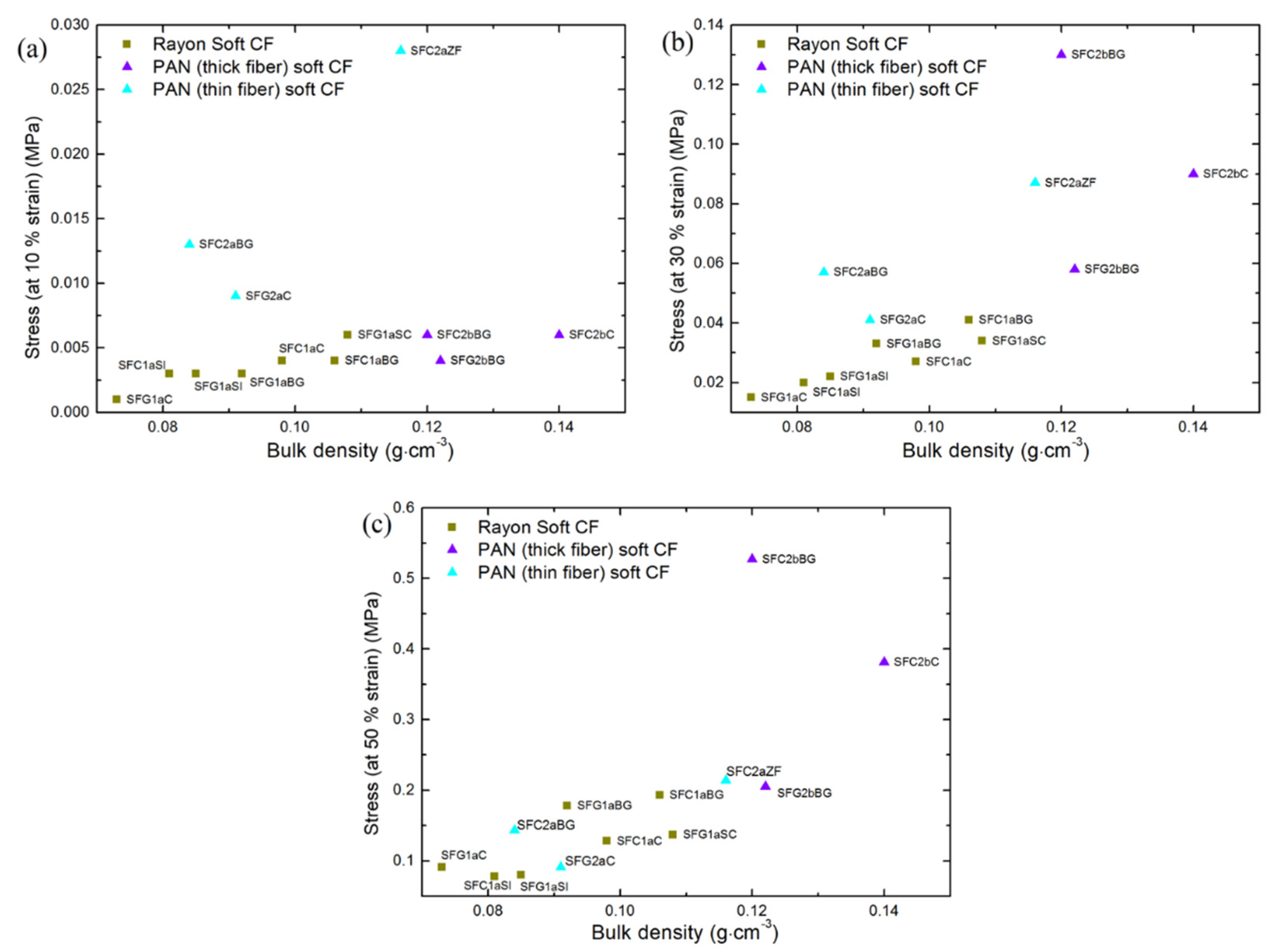
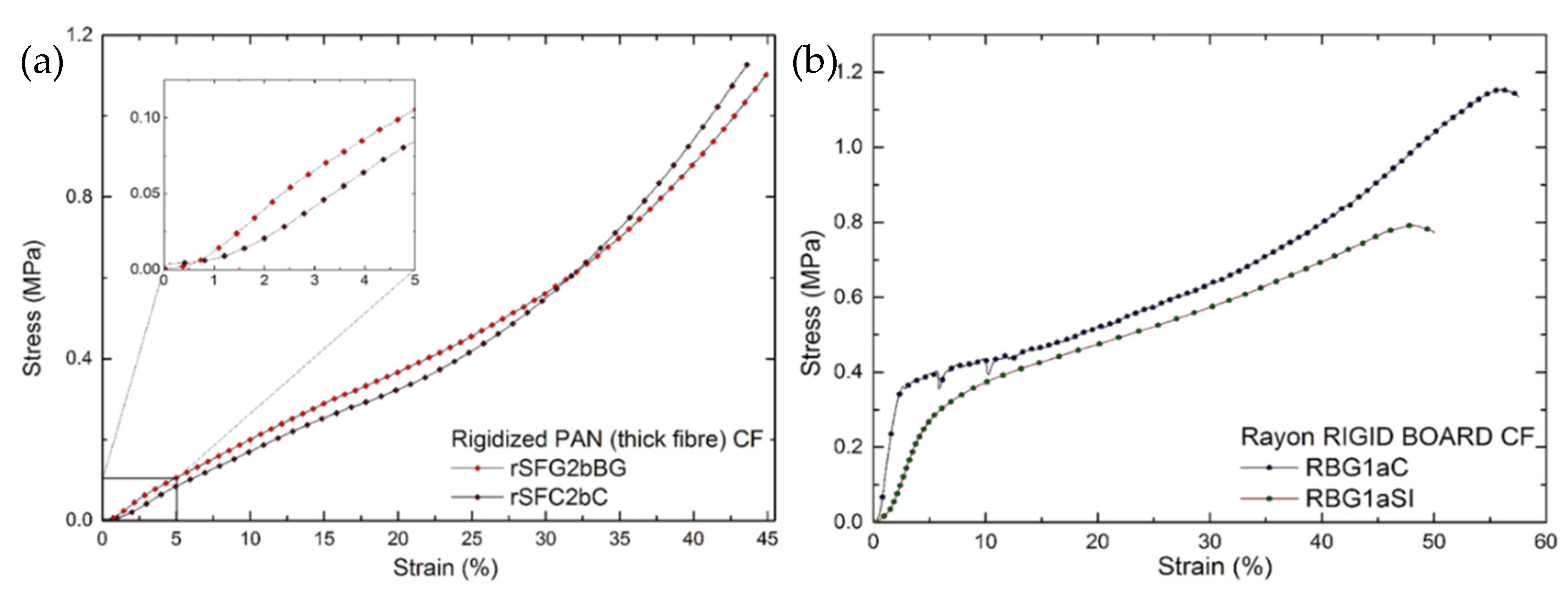
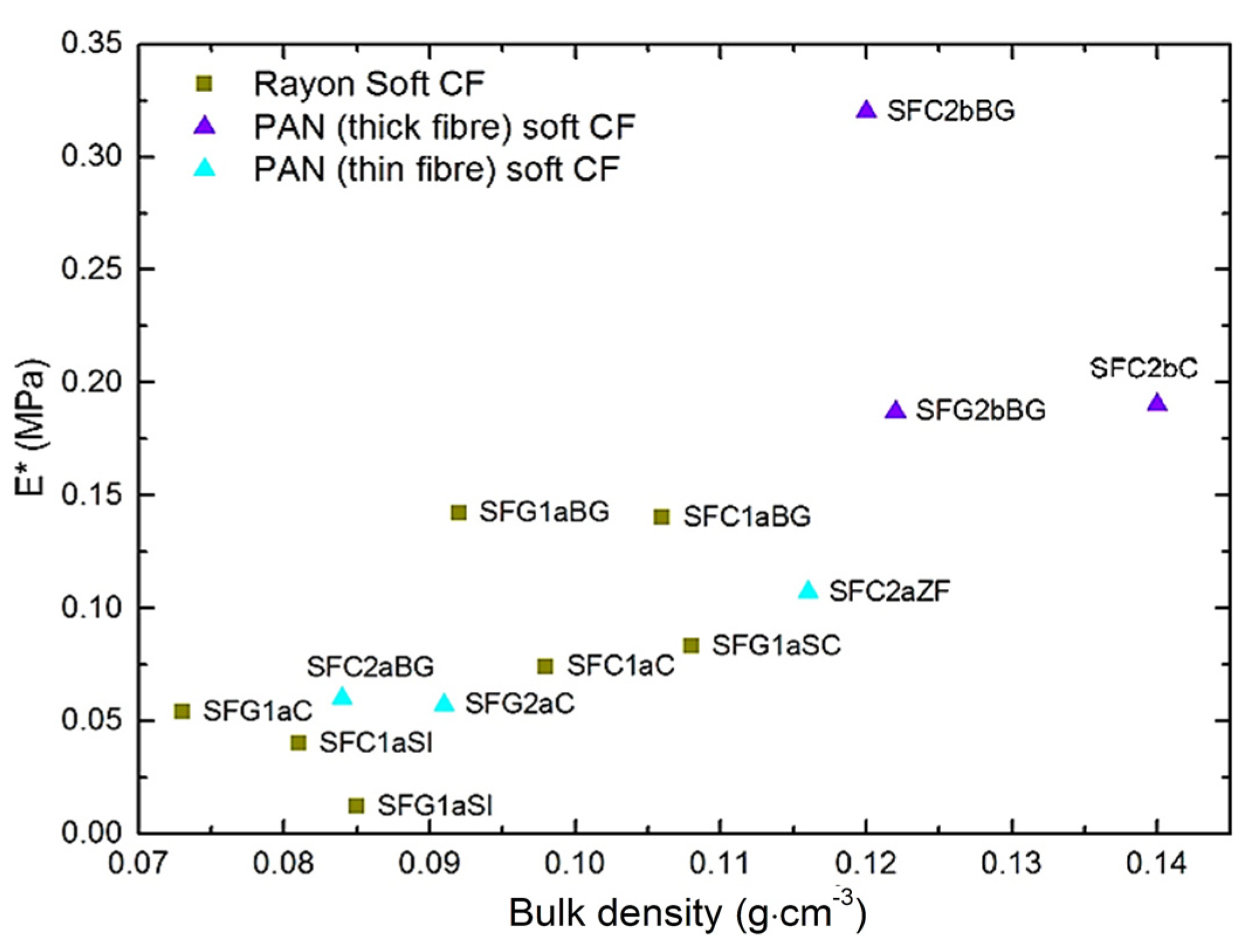
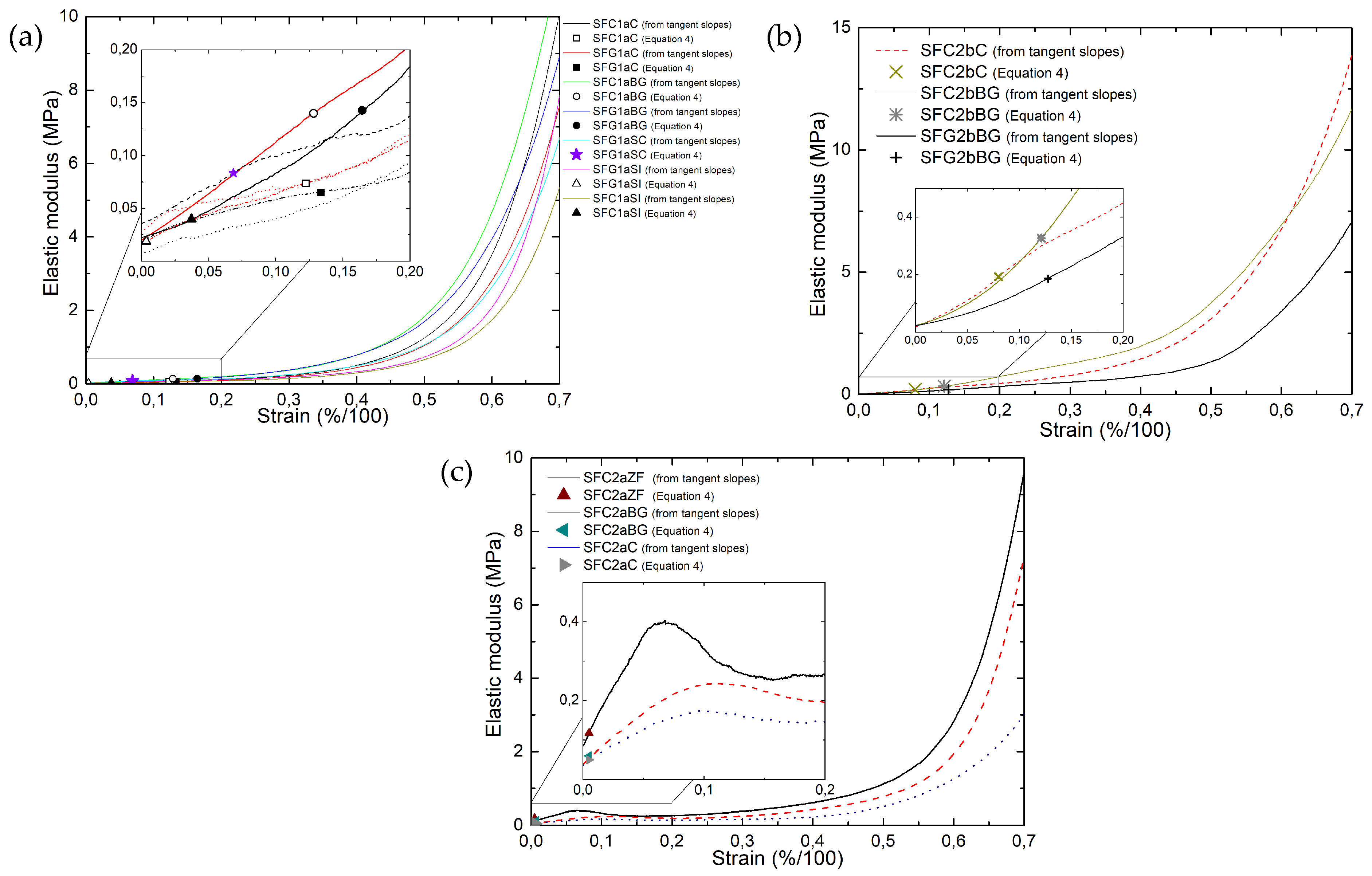

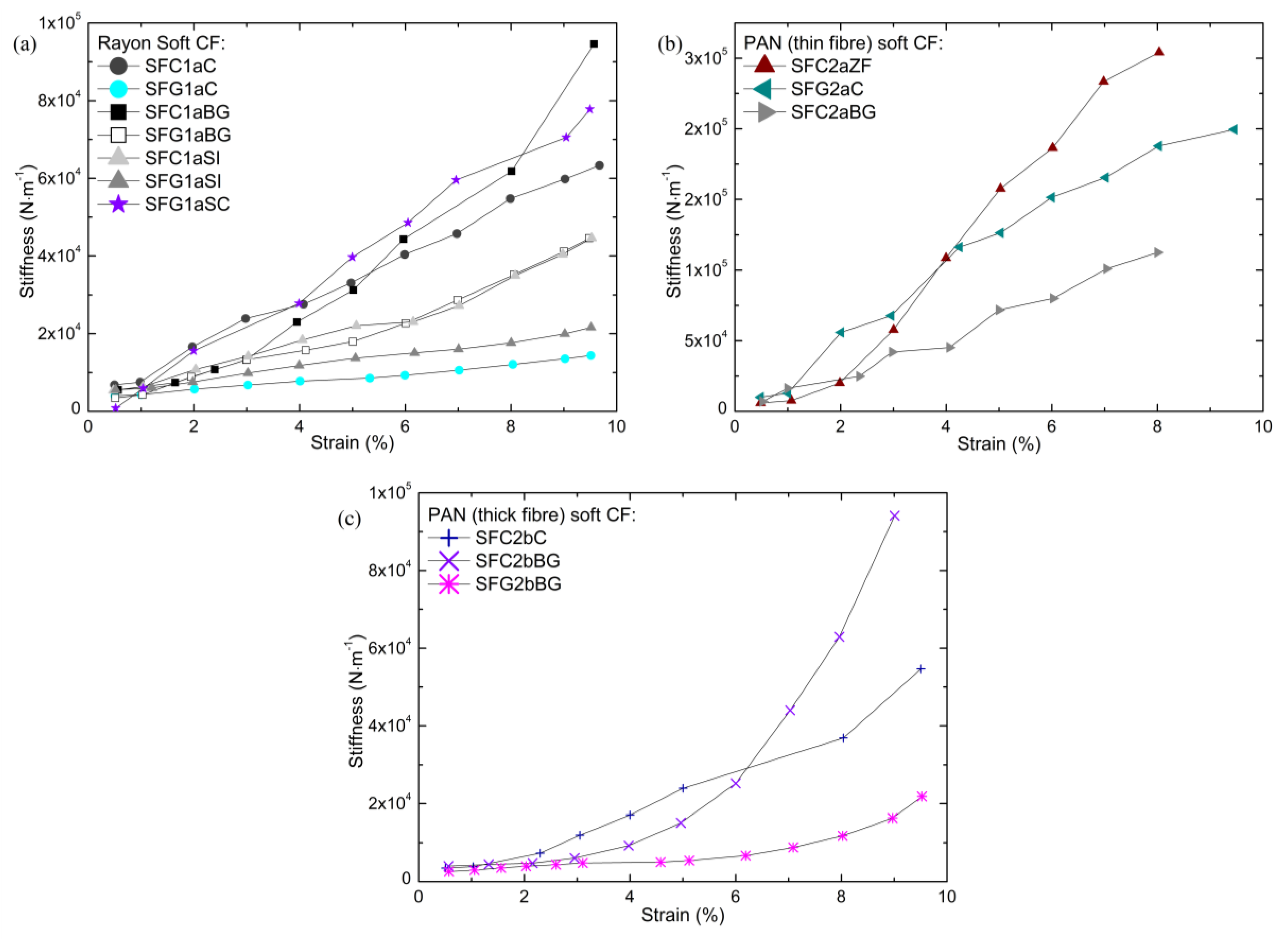
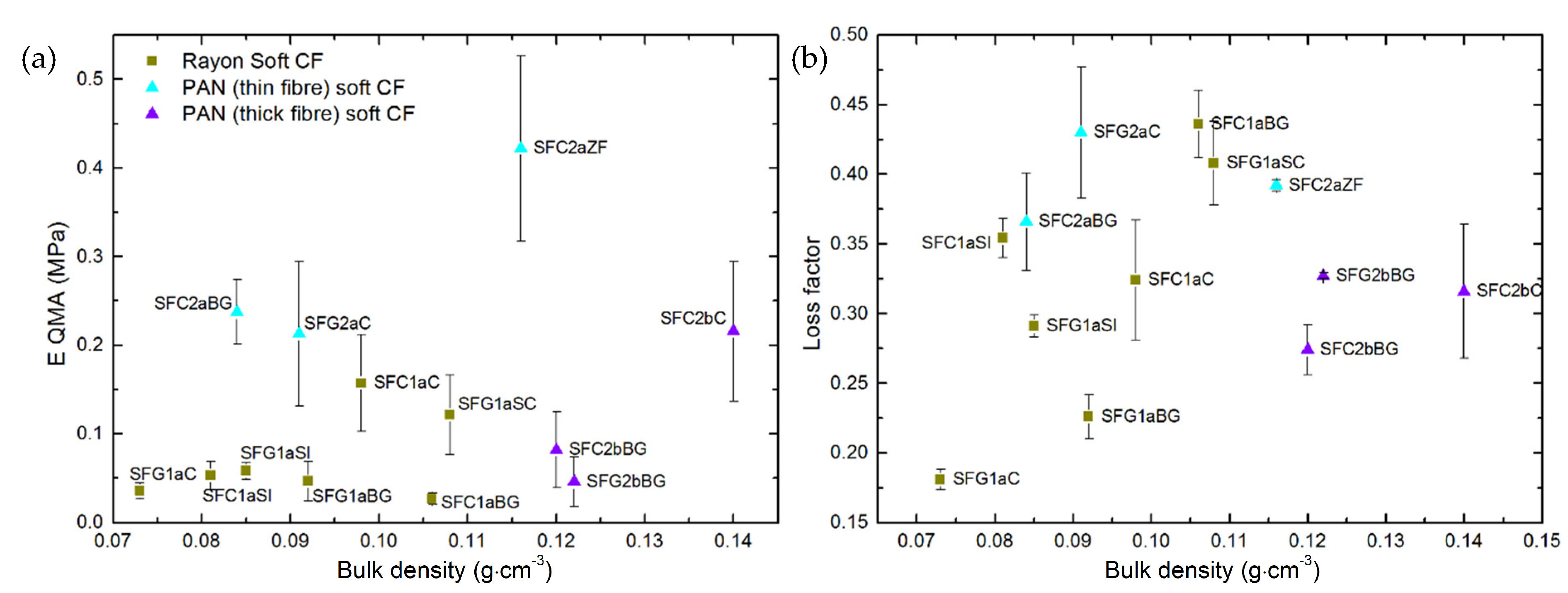
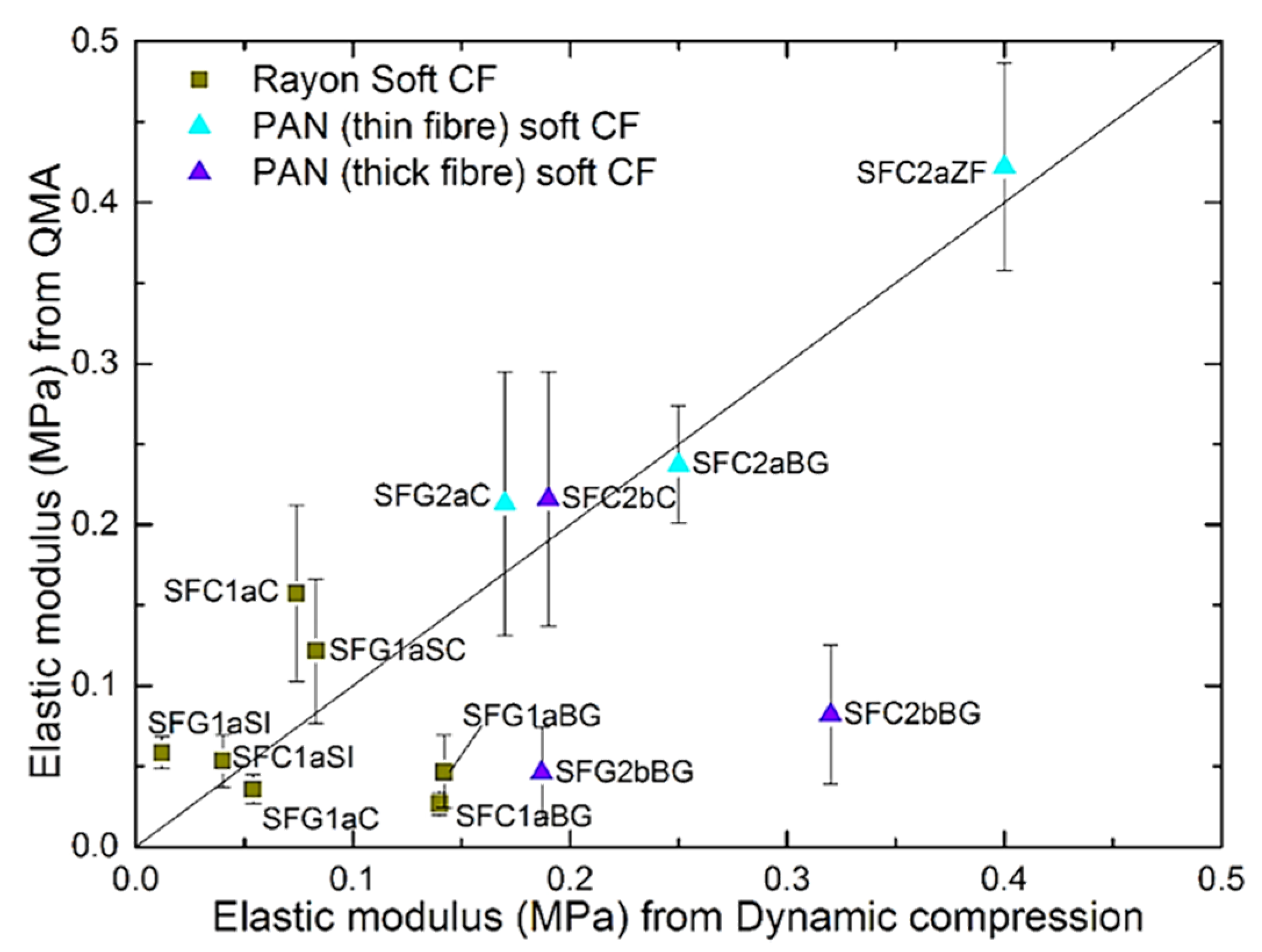

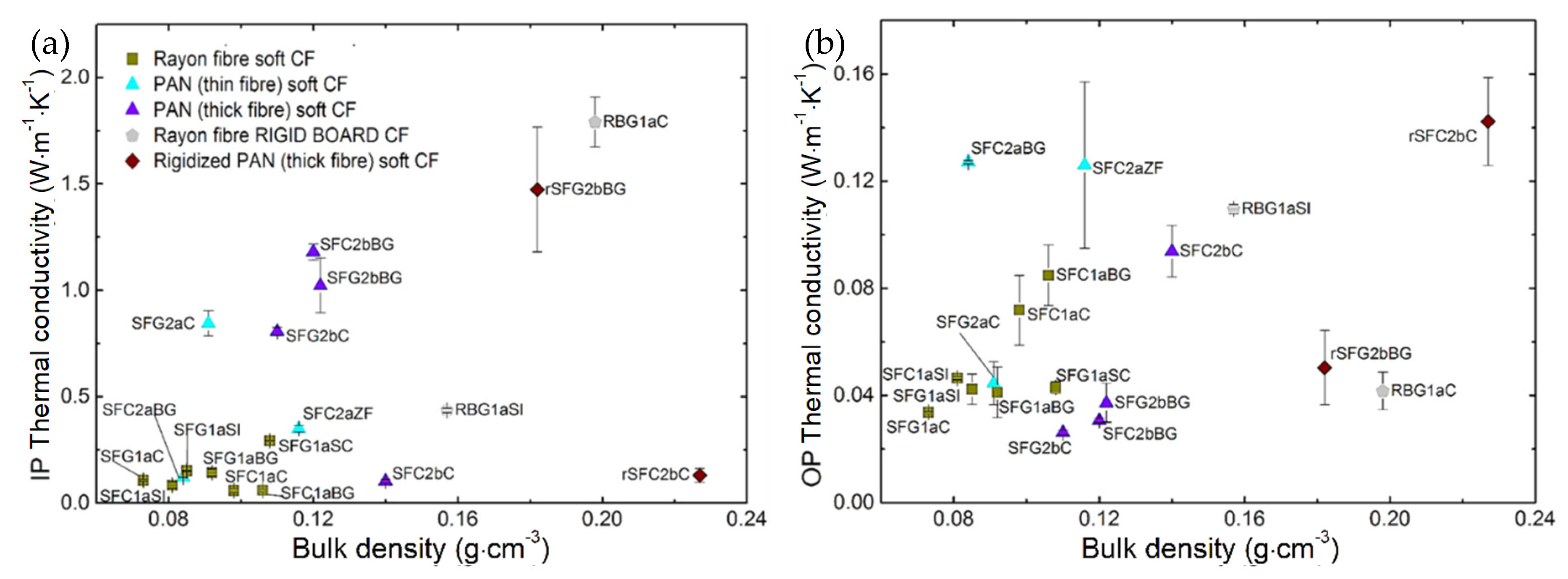
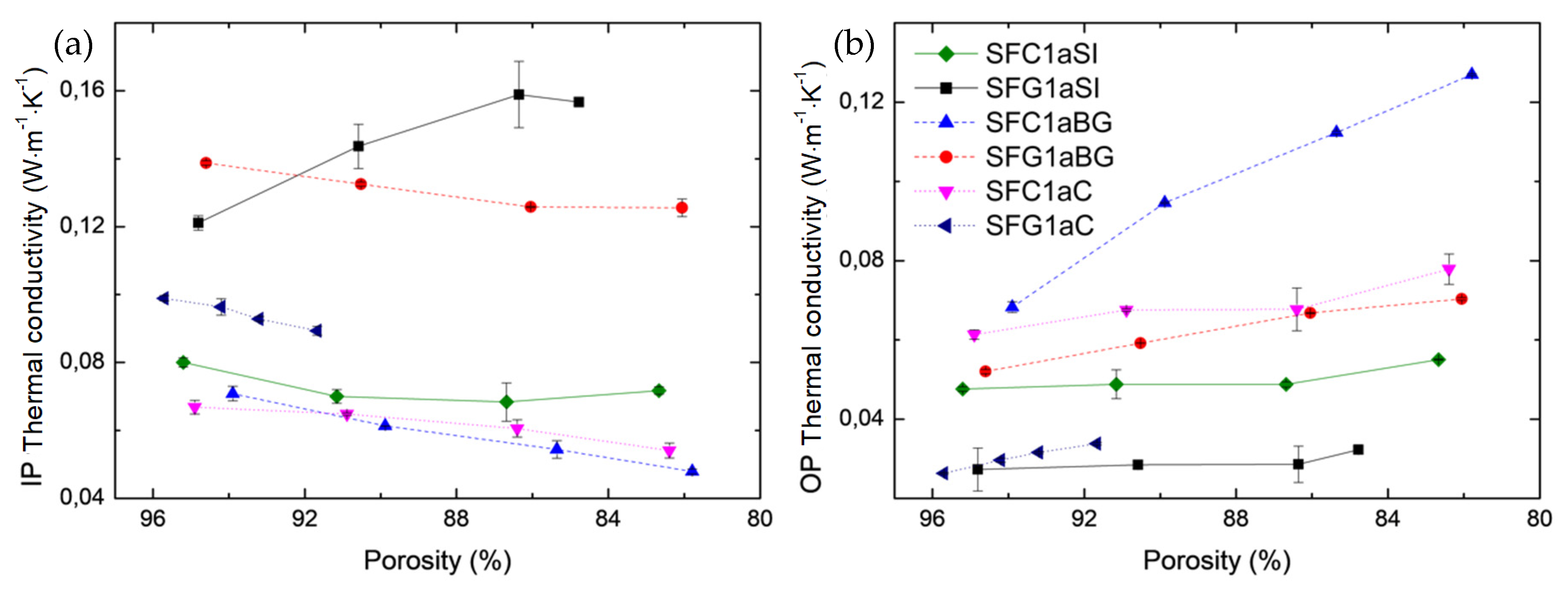
| Sample Code | Result (MPa) | Bulk Density (g cm−3) | Overall Porosity (%) | Elastic Modulus E (MPa) | Yield Stress (MPa) |
|---|---|---|---|---|---|
| Rigidized PAN (Thick Fibers) CFs | |||||
| rSFG2bBG | Ave. | 0.182 | 89.3 | 2.26 | 0.045 |
| Stdv. | 0.010 | — | 0.28 | 0.001 | |
| rSFC2bC | Ave. | 0.227 | 88.1 | 1.81 | 0.102 |
| Stdv. | 0.014 | — | 0.46 | 0.041 | |
| Rayon rigid boards | |||||
| RBG1aSI | Ave. | 0.157 | 89.6 | 13.48 | 0.171 |
| Stdv. | 0.012 | — | 0.25 | 0.001 | |
| RBG1aC | Ave. | 0.198 | 87.5 | 20.30 | 0.360 |
| Stdv. | 0.000 | — | 0.76 | 0.002 | |
| Sample Code | Experimental Data Fit with Equation (4) | Elastic Modulus E* | ||
|---|---|---|---|---|
| C10 | C01 | R2 | (MPa) | |
| RAYON soft CFs | ||||
| SFG1aBG | 0.031 | 0.005 | 0.992 | 0.142 |
| SFC1aBG | 0.026 | 0.009 | 0.991 | 0.140 |
| SFG1aSC | 0.016 | 0.005 | 0.996 | 0.083 |
| SFC1aC | 0.008 | 0.010 | 0.994 | 0.074 |
| SFG1aC | 0.005 | 0.009 | 0.994 | 0.054 |
| SFC1aSI | 0.004 | 0.005 | 0.997 | 0.040 |
| SFG1aSI | −0.009 | 0.012 | 0.999 | 0.012 |
| PAN (thin fibers) soft CFs | ||||
| SFC2aZF | 0.019 | 0.006 | 0.998 | 0.107 |
| SFC2aBG | 0.008 | 0.007 | 0.998 | 0.060 |
| SFC2aC | 0.013 | 0.001 | 0.998 | 0.057 |
| PAN (thick fibers) soft CFs | ||||
| SFC2bBG | 0.073 | 0.006 | 0.992 | 0.320 |
| SFC2bC | 0.030 | 0.016 | 0.996 | 0.190 |
| SFG2bBG | 0.049 | -0.002 | 0.994 | 0.187 |
Publisher’s Note: MDPI stays neutral with regard to jurisdictional claims in published maps and institutional affiliations. |
© 2021 by the authors. Licensee MDPI, Basel, Switzerland. This article is an open access article distributed under the terms and conditions of the Creative Commons Attribution (CC BY) license (https://creativecommons.org/licenses/by/4.0/).
Share and Cite
Karakashov, B.; Taghite, M.; Kouitat, R.; Fierro, V.; Celzard, A. Mechanical and Thermal Behavior of Fibrous Carbon Materials. Materials 2021, 14, 1796. https://doi.org/10.3390/ma14071796
Karakashov B, Taghite M, Kouitat R, Fierro V, Celzard A. Mechanical and Thermal Behavior of Fibrous Carbon Materials. Materials. 2021; 14(7):1796. https://doi.org/10.3390/ma14071796
Chicago/Turabian StyleKarakashov, Blagoj, M’Barek Taghite, Richard Kouitat, Vanessa Fierro, and Alain Celzard. 2021. "Mechanical and Thermal Behavior of Fibrous Carbon Materials" Materials 14, no. 7: 1796. https://doi.org/10.3390/ma14071796






